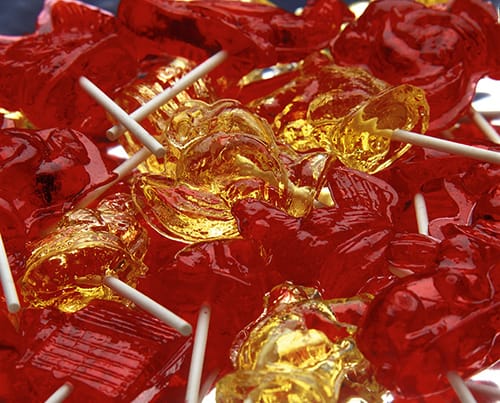Certain things in life just can't be improved upon.
The holidays were approaching when a woman and her daughter overheard a group of college students talking in a Toronto snack bar. Excitement built among the group as, one by one, they spoke of their plans to go home for Christmas. When one remained silent, his peers pressed him for an answer.
"No, my parents have given everything they can to help pay for my tuition, and I just can't afford to go home to the Maritimes for Christmas," he said. "What I'm going to miss most is the ribbon candy we always get at Christmas."
Was it a Christmas miracle that guided that woman to that particular snack bar to overhear that conversation? Maybe, for she was the wife of the national accounts manager for Robertson's Candy, of Truro, Nova Scotia, the very firm that had been producing ribbon candy for close to 75 years.

And was it fate that caused the woman to take her husband's car that night, (something she never does) in the trunk of which was one full box of ribbon candy?
The woman went to the car, and on returning approached the group. Singling out the Maritimer, "I couldn't help overhearing your conversation," she said, "I want you to have this box of ribbon candy."
This is when the tears may flow, as they did for the young man, who actually got down on his knees to thank the woman for giving him a piece of Christmas tradition that would otherwise have been missing.
Ribbon candy, a very delicate and complex process, is not available in most of Canada. It's a Maritimes thing that's taken for granted until it's no longer available. Then nostalgia sets in and the craving begins.
Roy Robertson, who bought the candy company from his father in 1977, hears such stories often, as does his marketing manager, Blaine Naugler.
Most are centred around the popular clear toys. Often called barley toys, or shapes, or animals, these molded candies on a stick, in colours of red and yellow, also fall under the nostalgia label.
"Clear toys are a family tradition in the Maritimes. Teenagers just take them for granted, but when they move away and can't get them, they become nostalgic about it," says Roy Robertson, popularly known as the Candy Man.
So they send letters, telling of their memories and ordering the clear toys or other Christmas candies, sometimes by the carton. Shipments have been made to New Zealand, Saudi Arabia, and even to Bosnia, but most go to Western Canada. "People from other parts know nothing about Christmas candies," says Blaine Naugler. "In Western Canada, they think it's all chocolate. But with so many Maritimers living there, we ship a lot of barley candy out west. They want to introduce the tradition to their grandchildren."
The candy is made today exactly as it was 75 years ago when Roy's father, William C. Robertson started the business. Most of the original equipment is still in use, and Roy's collection of Thomas Mills moulds is thought to be the largest in the world.
"I've got thousands of moulds, some as old as 150 years, and I wouldn't part with any of the big ones," Roy says. Among his favourites are a large deer, a horse, and a locomotive, which are used for individual clear toys available only at Christmas craft shows.
Blaine's favourite mould is a sailing ship, complete with all the rigging, which makes it very delicate and difficult to pack, but beautiful to look at.
 Apart from flavouring and colouring, only three ingredients are used in the making of Christmas candies-sugar, corn syrup and water. After boiling to the proper temperature in a large open copper pot, the mixture is dipped out by long-handled ladles, and rushed to the cold room where chilled moulds are set up and waiting to receive it. Sucker sticks are put in place as it cools, and when the mixture has cooled enough, the two-piece moulds are opened, the edges trimmed, if necessary, and the finished product goes on trays to be packed into 284-gram bags and sealed.
Apart from flavouring and colouring, only three ingredients are used in the making of Christmas candies-sugar, corn syrup and water. After boiling to the proper temperature in a large open copper pot, the mixture is dipped out by long-handled ladles, and rushed to the cold room where chilled moulds are set up and waiting to receive it. Sucker sticks are put in place as it cools, and when the mixture has cooled enough, the two-piece moulds are opened, the edges trimmed, if necessary, and the finished product goes on trays to be packed into 284-gram bags and sealed.
It's labour-intensive work because everything, from the weighing of ingredients to the packaging, is done by hand. Even the pulling to incorporate air into what will become the satin mix hard candies, is hand-done. A large piece of the cooling mixture is spun into a rope, and hung on a large hook on the wall to be pulled and pulled some more, until the mixture turns opaque and is cool enough to handle. Colour is then applied before it goes into a roller machine to be shaped and cut.
"There are eight different flavours and four different cuts, some long, some flat and some oval," Blaine says. "Everyone has his favourite, but one man said the best way to eat satin mix is to take five different flavours in your mouth at one time. What a burst of flavour!"
Although Robertson's Candy operates year-round with only four people on the job, the staff increases to 14 when experienced part-timers come on around the first of September to make the Christmas candy.
Maritimers at home will take it all for granted as they reach for their favourite candy, but there's good news for those living in other areas of Canada as well. For the first time, Robertson's clear toys will be sold in every Zeller's store across Canada. That's your Christmas gift from "the sweetest people in Truro."
The Candy Man was even willing to supply the recipe for those who want to make their own. Leaning back in his chair and folding his hands over his chest he asked: "What do you want? Hard candy? O.K.
"Take two cups of sugar, one cup of corn syrup and one cup of water. Cook to the hard boil (stage), 300 F. Pour onto a cold pan and let it cool a bit, then add your flavour, maybe oil of peppermint or vanilla, and colour. Use a spatula and keep turning it in to the centre for about 15 minutes, until it's cool enough to work. It's best to use oiled rubber gloves when handling. Then spin it into a rope and pull until it's opaque in colour and hard enough to cut."
Other Atlantic Candy Makers
Although we searched the length and breadth of Prince Edward Island, we were unable to turn up any makers of hard candy. Fudge and chocolates are made there, but Christmas candy is imported from Nova Scotia.
In St. Stephen, New Brunswick, Ganong's turns out the popular chicken bones, another seasonal treat from the Maritimes. Described as chocolate turned inside out, with a generous strand of unsweetened chocolate under a jacket of pink spicy cinnamon candy, chicken bones are another Maritime tradition that provokes a lot of sentiment, especially at holiday time. Invented in 1885 by Ganong's candy maker Frank Sparhawk, it quickly became and has remained a favourite candy of Maritimers, no matter where they live.
Founded in 1873, Ganong's is Canada's oldest independent candy company, well known for its quality chocolates which are shipped to countries around the world.
How well such candies appease the sweet tooth of Newfoundlanders and Labradorians is a question to ponder, for most are loyal supporters of the peppermint nobs (knobs) made by Purity Factories Limited in St. John's. These pink, hand-sugared candies have been made since the 1920s, not only for Christmas, but all year round.
